
Ferromagnetism is a property of certain materials that results in a significant, observable magnetic permeability, and in many cases, a significant magnetic coercivity, allowing the material to form a permanent magnet. Ferromagnetic materials are noticeably attracted to a magnet, a consequence of their substantial magnetic permeability.
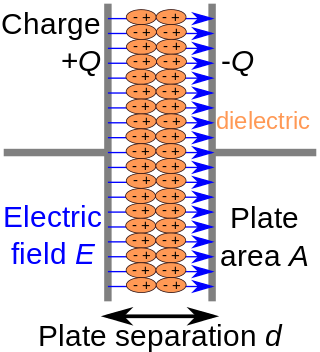
In electromagnetism, a dielectric is an electrical insulator that can be polarised by an applied electric field. When a dielectric material is placed in an electric field, electric charges do not flow through the material as they do in an electrical conductor, because they have no loosely bound, or free, electrons that may drift through the material, but instead they shift, only slightly, from their average equilibrium positions, causing dielectric polarisation. Because of dielectric polarisation, positive charges are displaced in the direction of the field and negative charges shift in the direction opposite to the field. This creates an internal electric field that reduces the overall field within the dielectric itself. If a dielectric is composed of weakly bonded molecules, those molecules not only become polarised, but also reorient so that their symmetry axes align to the field.
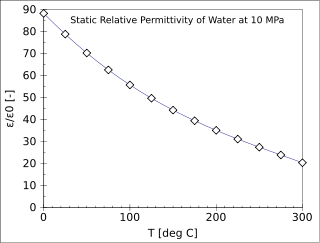
The relative permittivity is the permittivity of a material expressed as a ratio with the electric permittivity of a vacuum. A dielectric is an insulating material, and the dielectric constant of an insulator measures the ability of the insulator to store electric energy in an electrical field.
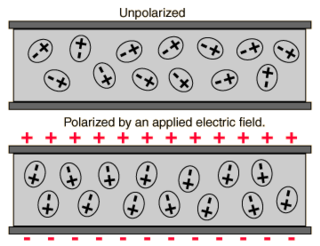
In electromagnetism, the absolute permittivity, often simply called permittivity and denoted by the Greek letter ε (epsilon), is a measure of the electric polarizability of a dielectric. A material with high permittivity polarizes more in response to an applied electric field than a material with low permittivity, thereby storing more energy in the material. In electrostatics, the permittivity plays an important role in determining the capacitance of a capacitor.

Pyroelectricity is a property of certain crystals which are naturally electrically polarized and as a result contain large electric fields. Pyroelectricity can be described as the ability of certain materials to generate a temporary voltage when they are heated or cooled. The change in temperature modifies the positions of the atoms slightly within the crystal structure, so that the polarization of the material changes. This polarization change gives rise to a voltage across the crystal. If the temperature stays constant at its new value, the pyroelectric voltage gradually disappears due to leakage current. The leakage can be due to electrons moving through the crystal, ions moving through the air, or current leaking through a voltmeter attached across the crystal.

Polyvinylidene fluoride or polyvinylidene difluoride (PVDF) is a highly non-reactive thermoplastic fluoropolymer produced by the polymerization of vinylidene difluoride. Its chemical formula is (C2H2F2)n.
In physics, the electromagnetic dual concept is based on the idea that, in the static case, electromagnetism has two separate facets: electric fields and magnetic fields. Expressions in one of these will have a directly analogous, or dual, expression in the other. The reason for this can ultimately be traced to special relativity, where applying the Lorentz transformation to the electric field will transform it into a magnetic field. These are special cases of duality in mathematics.

In classical electromagnetism, polarization density is the vector field that expresses the volumetric density of permanent or induced electric dipole moments in a dielectric material. When a dielectric is placed in an external electric field, its molecules gain electric dipole moment and the dielectric is said to be polarized.

In physics, the electric displacement field or electric induction is a vector field that appears in Maxwell's equations. It accounts for the electromagnetic effects of polarization and that of an electric field, combining the two in an auxiliary field. It plays a major role in topics such as the capacitance of a material, as well the response of dielectrics to electric field, and how shapes can change due to electric fields in piezoelectricity or flexoelectricity as well as the creation of voltages and charge transfer due to elastic strains.
Polarizability usually refers to the tendency of matter, when subjected to an electric field, to acquire an electric dipole moment in proportion to that applied field. It is a property of particles with an electric charge. When subject to an electric field, the negatively charged electrons and positively charged atomic nuclei are subject to opposite forces and undergo charge separation. Polarizability is responsible for a material's dielectric constant and, at high (optical) frequencies, its refractive index.
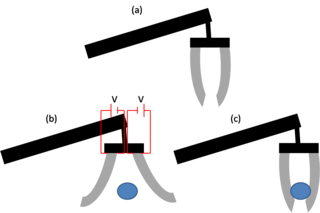
An electroactive polymer (EAP) is a polymer that exhibits a change in size or shape when stimulated by an electric field. The most common applications of this type of material are in actuators and sensors. A typical characteristic property of an EAP is that they will undergo a large amount of deformation while sustaining large forces.
Multiferroics are defined as materials that exhibit more than one of the primary ferroic properties in the same phase:

In electromagnetism, Jefimenko's equations give the electric field and magnetic field due to a distribution of electric charges and electric current in space, that takes into account the propagation delay of the fields due to the finite speed of light and relativistic effects. Therefore, they can be used for moving charges and currents. They are the particular solutions to Maxwell's equations for any arbitrary distribution of charges and currents.
Oleg Dmitrovich Jefimenko was a physicist and professor emeritus at West Virginia University.
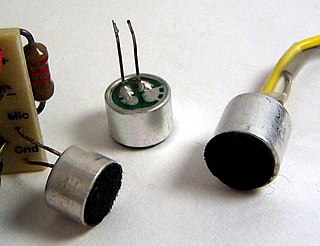
An electret microphone is a type of electrostatic capacitor-based microphone, which eliminates the need for a polarizing power supply by using a permanently charged material.
A ferroelectret, also known as a piezoelectret, is a thin film of polymer foams, exhibiting piezoelectric and pyroelectric properties after electric charging. Ferroelectret foams usually consist of a cellular polymer structure filled with air. Polymer-air composites are elastically soft due to their high air content as well as due to the size and shape of the polymer walls. Their elastically soft composite structure is one essential key for the working principle of ferroelectrets, besides the permanent trapping of electric charges inside the polymer voids. The elastic properties allow large deformations of the electrically charged voids. However, the composite structure can also possibly limit the stability and consequently the range of applications.

Sérgio Mascarenhas de Oliveira was a Brazilian experimental physicist, educator and scientific leader. He was awarded several prizes including the Brazilian Order of Scientific Merit in the categories of Commander and Great Cross, the Conrado Wessel Prize for General Science, the Joaquim da Costa Ribeiro Prize and the Guggenheim Fellowship.

Ferroelectric polymers are a group of crystalline polar polymers that are also ferroelectric, meaning that they maintain a permanent electric polarization that can be reversed, or switched, in an external electric field.
Reimund Gerhard is a German applied physicist and university professor. Between 1979 and 2006 he used the last name "Gerhard-Multhaupt".
A ferroelectric field-effect transistor is a type of field-effect transistor that includes a ferroelectric material sandwiched between the gate electrode and source-drain conduction region of the device. Permanent electrical field polarisation in the ferroelectric causes this type of device to retain the transistor's state in the absence of any electrical bias.












